- Home
- Timothy Egan
The Worst Hard Time: The Untold Story of Those Who Survived the Great American Dust Bowl
The Worst Hard Time: The Untold Story of Those Who Survived the Great American Dust Bowl Read online
The Worst Hard Time
The Untold Story of Those Who Survived the Great American Dust Bowl
Timothy Egan
Table of Contents
Title Page
Table of Contents
...
Copyright
Dedication
...
Epigraph
Contents
Dustbowl Map
Introduction: Live Through This
I PROMISE
1. The Wanderer
2. No Man's Land
3. Creating Dalhart
4. High Plains Deutsch
5. Last of the Great Plowup
II BETRAYAL
6. First Wave
7. A Darkening
8. In a Dry Land
9. New Leader, New Deal
10. Big Blows
III BLOWUP
11. Triage
12. The Long Darkness
13. The Struggle for Air
14. Showdown in Dalhart
15. Duster's Eve
16. Black Sunday
17. A Call to Arms
18. Goings
19. Witnesses
20. The Saddest Land
21. Verdict
22. Cornhusker II
23. The Last Men
24. Cornhusker III
25. Rain
Epilogue
...
Notes and Sources
Acknowledgments
Index
HOUGHTON MIFFLIN COMPANY
Boston • New York
2006
Copyright © 2006 by Timothy Egan
ALL RIGHTS RESERVED
For information about permission to reproduce selections from this book,
write to Permissions, Houghton Mifflin Company, 215 Park Avenue South,
New York, New York 10003.
Visit our Web site: www.houghtonmifflinbooks.com.
Library of Congress Cataloging-in-Publication Data
Egan, Timothy.
The worst hard time : the untold story of those who survived the great
American dust bowl / Timothy Egan.
p. cm.
ISBN-13: 978-0-618-34697-4
ISBN-10: 0-618-34697-X
1. Dust Bowl Era, 1931–1939. 2. Droughts—Great Plains—History—
20th century. 3. Dust storms—Great Plains—History—20th century.
4. Depressions—1929—Great Plains. 5. Great Plains—History—20th century.
6. Great Plains—Social conditions—20th century. I. Title.
F595.E38 2006
978'.032—DC22 2005008057
Book design by Melissa Lotfy
Map by Jacques Chazaud
PRINTED IN THE UNITED STATES OF AMERICA
QUM 10 9 8 7 6 5 4 3 2 1
PHOTO CREDITS: Western History Collections, University of Oklahoma Li-
braries: [>], [>], [>], [>], [>], [>], and [>]; Library of Congress, Prints & Pho-
tographs Division, FSA/OWI Collection: [>], LC-USF34-034129-D DLC; [>],
LC-USF34-004223-E DLC; [>], LC-DIG-FSA-8B38341; [>], LC-USF34-004078-E;
[>], LC-USF34-004051-E; [>], LC-USZ62-47982 DLC; [>], LC-USF34-004053-
E-DLC; [>], LC-USF34-004091-E; [>], LC-USF34-005244-E DLC; Denver Public
Library, Western History Collection: [>] and [>].
To my dad, raised by his widowed mother during the darkest years of the Great Depression, four to a bedroom. Among many things he picked up from her was this skill: never let the kids see you sweat.
"Between the earth and that sky I felt erased, blotted out."
—WILLA CATHER
Contents
Introduction: Live Through This 1
I • PROMISE: The Great Plowup, 1901–1930
1. The Wanderer [>]
2. No Man's Land [>]
3. Creating Dalhart [>]
4. High Plains Deutsch [>]
5. Last of the Great Plowup [>]
II • BETRAYAL, 1931–1933
6. First Wave [>]
7. A Darkening [>]
8. In a Dry Land [>]
9. New Leader, New Deal [>]
10. Big Blows [>]
III • BLOWUP, 1934–1939
11. Triage [>]
12. The Long Darkness [>]
13. The Struggle for Air [>]
14. Showdown in Dalhart [>]
15. Duster's Eve [>]
16. Black Sunday [>]
17. A Call to Arms [>]
18. Goings [>]
19. Witnesses [>]
20. The Saddest Land [>]
21. Verdict [>]
22. Cornhusker II [>]
23. The Last Men [>]
24. Cornhusker III [>]
25. Rain [>]
Epilogue [>]
Notes and Sources [>]
Acknowledgments [>]
Index [>]
Introduction: Live Through This
ON THOSE DAYS when the wind stops blowing across the face of the southern plains, the land falls into a silence that scares people in the way that a big house can haunt after the lights go out and no one else is there. It scares them because the land is too much, too empty, claustrophobic in its immensity. It scares them because they feel lost, with nothing to cling to, disoriented. Not a tree, anywhere. Not a slice of shade. Not a river dancing away, life in its blood. Not a bump of high ground to break the horizon, give some perspective, spell the monotone of flatness. It scares them because they wonder what is next. It scared Coronado, looking for cities of gold in 1541. It scared the Anglo traders who cut a trail from Independence to Santa Fe, after they dared let go of the lifeline of the Cimarron River in hopes of shaving a few days off a seven-week trek. It even scared some of the Comanche as they chased bison over the grass. It scared the Germans from Russia and the Scots-Irish from Alabama—the Last Chancers, exiled twice over, looking to build a hovel from overturned sod, even if that dirt house was crawling with centipedes and snakes, and leaked mud on the children when thunderheads broke.
It still scares people driving cars named Expedition and Outlander. It scares them because of the forced intimacy with a place that gives nothing back to a stranger, a place where the land and its weather—probably the most violent and extreme on earth—demand only one thing: humility.
Throughout the Great Plains, a visitor passes more nothing than something. Or so it seems. An hour goes by on the same straight line and then up pops a town on a map—Twitty, Texas, or Inavale, Nebraska. The town has slipped away, dying at some point without funeral or proper burial.
In other places, scraps of life are frozen in death at midstride, as Lot's wife was petrified to salt while fleeing to higher ground. Here is a wood-framed shack buried by sand, with only the roof joists still visible. In the distance is a copse of skeletal trees, the bones of orchards dried to a brittleness like charcoal. And is that a schoolhouse, with just the chimney and two walls still standing? Then you see fence posts, the nubs sticking out of sterile brown earth. Once, the posts enclosed an idea that something could come from a shank of the southern plains to make life better than it was in a place that an Ehrlich, an O'Leary, or a Montoya had left. The fence posts rose six feet or more out of the ground. They are buried now but for the nubs that poke through layers of dust.
In those cedar posts and collapsed homes is the story of this place: how the greatest grassland in the world was turned inside out, how the crust blew away, raged up in the sky and showered down a suffocating
blackness off and on for most of a decade. In parts of Nebraska, Kansas, Colorado, New Mexico, Oklahoma, and Texas, it seemed on many days as if a curtain were being drawn across a vast stage at world's end. The land convulsed in a way that had never been seen before, and it did so at a time when one out of every four adults was out of work. The people who live here now, the ones who never left, are still trying to make sense of why the earth turned on them. Much as they love this place, their doubts run deep. Was it a mistake to hang on? Will they be the last generation to inhabit the southern plains? And some feel deep shame—for the land's failure, and their part in it. Outside Inavale not long ago, an old woman was found burning a Dust Bowl diary written by her husband. Her neighbor was astonished: why destroy such an intimate family record? The horror, the woman explained, was not worth sharing. She wanted it gone forever.
Fence tops lead to small farms, some still pulsing with life, and lead further to towns that service what is left of the homestead sections. Here is Springfield, standing for another day in Baca County, in the far southeast corner of Colorado, with Kansas on its eastern side, the No Man's Land of the Oklahoma Panhandle to the south, a piece of New Mexico in another corner. For sale signs. A mini-mart. A turkey buzzard perched on a tower near city hall. Springfield is the county seat for Baca, which has about four thousand people spread over its wrinkled emptiness—fewer than two people per square mile. A hundred years ago, a county with population density this low was classified as "frontier." By that definition, there is far more frontier now in this part of the world than in the day of the sod house. The town has the High Plains look, that slow-death shudder. They have not tried to dress it up or put makeup on battered storefronts. It is what it is. No flashing banners. No pretense.
A few blocks off Main Street is a house of sturdy stone. A bang on the door brings a small, brittle woman to the porch.
"I'm looking for Isaac Osteen."
"Ike?" Her voice is from somewhere long ago. "You want Ike?"
"Sure."
"He's up on the ladder, fixing the roof. Out back."
The roof is steep-pitched, a challenge for the nimble. Ike Osteen is eighty-six years old. He scrambles to the edge, a twenty-five-foot drop to the ground.
"Hello, there," he says. He is springy still, with liquid blue eyes, a full head of silver hair.
"Morning."
"You wanna talk about this drouth."
It is never drought in the southern plains.
All around him, the land is drying up again, a few years into the new century. The snow never came to many parts of the Rockies this year, and where it did fall, there is nothing left. The white reservoir of mountain snowpack—feeding the Arkansas River, the Cimarron, the little dribs and drabs pulled from high peaks to the prairie—is anemic. To some people, most of them too young to know better, this dead dry spell is like another era. A second Dust Bowl, they say.
"Nobody who lived through the Dirty Thirties believes that," says Ike, one foot prodding for the ladder. "Just wasn't any comparison."
One of nine kids, Ike Osteen grew up in a dugout. A dugout is just that—a home dug into the hide of the prairie. The floor was dirt. Above ground, the walls were plank boards, with no insulation on the inside and black tarpaper on the outside. Every spring, Ike's mother poured boiling water over the walls to kill fresh-hatched bugs. The family heated the dugout with cow chips, which burned in an old stove and left a turd smell slow to dissipate. The toilet was outside, a hole in the ground. Water was hauled in from a deeper hole in the ground. Ike's mother was Irish; he is not sure about his father's side.
"I was born in America, that's as far as I need to go."
His father had followed the old Santa Fe Trail in 1909, the year Congress tried to induce settlement in one of the final frontiers of the public domain—the arid, western half of the Great Plains—with a homestead act that doubled the amount of land a person could prove-up and own to 320 acres. The last homestead act was a desperate move, promoted by railroad companies and prairie state senators, to get people to inhabit a place that had never held anything more than a few native hunting camps and some thirteenth-century Indian villages.
The Osteens were following a rumor: there was supposed to be a dam going up on the Cimarron River in No Man's Land that needed hired hands.
"They got down there with their horses and wagon, and they were told there weren't any jobs. But people said, If you like this area, you can get 320 acres for the asking. They looked around over the border into Colorado and said, Well here's a perfectly flat piece of ground and there aren't any rocks on it. It was nothing but prairie grass. They dug down with a shovel. Saw it wasn't sand. The sod went down deep. Let's homestead this."
Ike's father died at the age of forty-six. He left behind a widowed mother of nine in a cramped hole in the ground in the middle of the High Plains. The Osteens had the wind and 320 acres of land. The wind powered a windmill, which pumped water 140 feet up from the Ogallala Aquifer. The water was piped into small storage tanks. Cattle drank from the tanks and fattened easily on the rich grass. That was all you needed to stay alive: water and grass. If the wind ever stopped blowing for long, the Osteens fell into that fear that comes when the land goes mute. Without the wind, there was no water, no cattle, no life. The cows produced milk and thick cream. The cream was brought into town and swapped straight up for flour, coffee, sugar, a jar of hooch. The family had hens in a coop, laying a regular supply of eggs, and a .22 caliber rifle.
In 1929, the start of the Great Depression, the boys rode a mule to school. For the next nine years, Ike would see Baca County go mad. Earlier, the land had been overturned in a great speculative frenzy to make money in an unsustainable wheat market. After a big run-up, prices crashed. The rains disappeared—not just for a season but for years on end. With no sod to hold the earth in place, the soil calcified and started to blow. Dust clouds boiled up, ten thousand feet or more in the sky, and rolled like moving mountains—a force of their own. When the dust fell, it penetrated everything: hair, nose, throat, kitchen, bedroom, well. A scoop shovel was needed just to clean the house in the morning. The eeriest thing was the darkness. People tied themselves to ropes before going to a barn just a few hundred feet away, like a walk in space, tethered to the life support center. Chickens roosted in midafternoon.
"There'd be days, you couldn't see your hand in front a' your face," Osteen says, using the exact words that other people from his generation use. They know some people do not believe them, just as many in the East did not believe the initial accounts of predatory dust until a storm in May 1934 carried the windblown shards of the Great Plains over much of the nation. In Chicago, twelve million tons of dust fell. New York, Washington—even ships at sea, three hundred miles off the Atlantic coast—were blanketed in brown.
Cattle went blind and suffocated. When farmers cut them open, they found stomachs stuffed with fine sand. Horses ran madly against the storms. Children coughed and gagged, dying of something the doctors called "dust pneumonia." In desperation, some families gave away their children. The instinctive act of hugging a loved one or shaking someone's hand could knock two people down, for the static electricity from the dusters was so strong. Ike Osteen's life spans the flu epidemic of 1918, the worst depression in American history, and a world war that ripped apart the globe. Nothing compares to the black dusters of the 1930s, he says, a time when the simplest thing in life—taking a breath—was a threat.
Up the road from Baca County, the fence posts lead to another witness, Jeanne Clark. She narrows her eyes in the hard prairie sunlight, stirred by memory. Her constant companion, an oxygen cylinder, is by her side on a wheeled cart. She is alone in the place where she spent most of her life. It is so hard to laugh, and Jeanne Clark, whose personality is like seltzer water, has always liked to laugh. Her lungs, scarred from dust pneumonia, hold a small part of the story. When doctors first examined her lungs they thought she surely had suffered from tuberculosis. No, sir. It wa
s the black dusters of the 1930s.
"I still have terrible nightmares," she says.
Jeanne's mother, Louise Walton, was a Broadway dancer and actress, a lively, high-stepping woman who seemed headed for the big time after landing a role in "The George White Scandal." But the late nights and hard living of New York took a toll on her. Her health broke down; her breathing became erratic. Doctors prescribed a remedy: go west, to the southern plains, go west to breathe. She took the train from New York, traveling through Chicago, St. Louis, Topeka, Garden City. When at last she landed in Lamar, Colorado, it was as if she had left the planet. There was no green. No lights at night. No buzz of purpose or industry. God, it was flat. Like a brown ocean. A stranger asked Louise: "Why are you here?"
"For the air," she said. "For the air."
The prescription, geography as therapy, had worked for others. Since the late nineteenth century, the western plains had been a haven for "lungers," as pilgrims with respiratory ailments were called. It was not just Doc Holliday, the killer and homeschooled dentist, who came to Kansas to remedy his tuberculosis. Every good-sized town in the arid belt had a sanatorium offering various amenities. For a while, Colorado City was so full of English-accented patients fleeing the foul industrial air of urban Britain that it was known as Little London. A doctor met Louise Walton at the train station and directed her to the nicest building in town, the hospital.
Over several years, Louise's health did improve. Her energy came back. She married a rancher and had a little girl, Jeanne. The Broadway dancer, the rancher, and their young daughter were just starting to build a life in the flatlands when the sky turned lethal. By 1934, the soil was like fine-sifted flour, and the heat made it a danger to go outside many days. In Vinita, Oklahoma, the temperature soared above 100 degrees for thirty-five consecutive days. On the thirty-sixth day, it reached 117. It was a time without air conditioning, of course, a time without even electricity for most farmers in the southern plains.
On the skin, the dust was like a nail file, a grit strong enough to hurt. People rubbed Vaseline in their nostrils as a filter. The Red Cross handed out respiratory masks to schools. Families put wet towels beneath their doors and covered their windows with bed sheets, fresh-dampened nightly. The sheets turned a muddy brown. At school, Jeanne Clark, the New York dancer's daughter, went through dust drills. When the storms hit, they usually came without warning. Weather forecasting, with no pictures from high above, relied on changes in atmospheric pressure, but such measures rarely picked up galloping earth. Dusters went undetected until they rolled into a neighboring town and a phone link was set in motion.

 The Immortal Irishman
The Immortal Irishman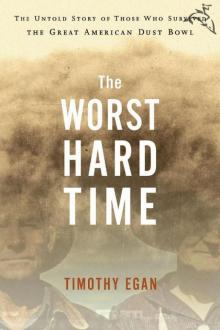 The Worst Hard Time: The Untold Story of Those Who Survived the Great American Dust Bowl
The Worst Hard Time: The Untold Story of Those Who Survived the Great American Dust Bowl The Good Rain: Across Time & Terrain in the Pacific Northwest
The Good Rain: Across Time & Terrain in the Pacific Northwest Breaking Blue
Breaking Blue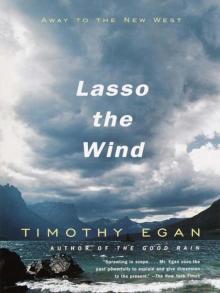 Lasso the Wind: Away to the New West
Lasso the Wind: Away to the New West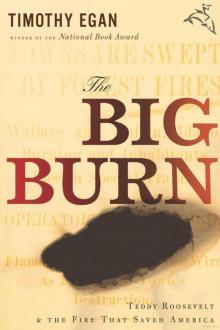 The Big Burn: Teddy Roosevelt and the Fire That Saved America
The Big Burn: Teddy Roosevelt and the Fire That Saved America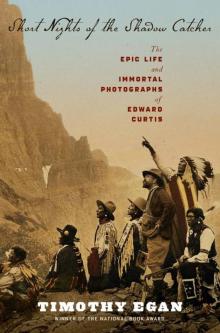 Short Nights of the Shadow Catcher
Short Nights of the Shadow Catcher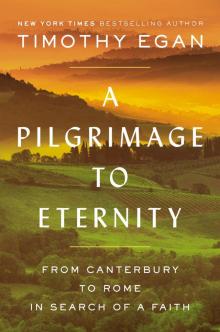 A Pilgrimage to Eternity
A Pilgrimage to Eternity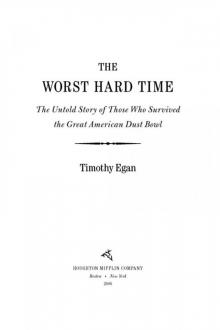 The Worst Hard Time
The Worst Hard Time The Big Burn
The Big Burn